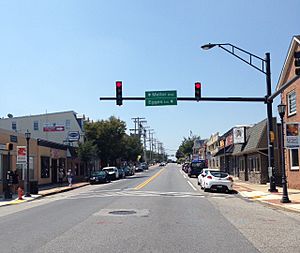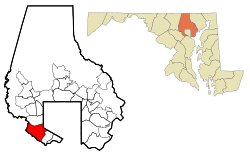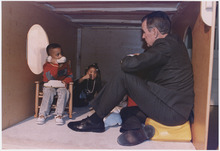Catonsville, Maryland facts for kids
Quick facts for kids
Catonsville, Maryland
|
|
|---|---|

Frederick Road in Downtown Catonsville.
|
|
| Nicknames:
"Music City, Maryland", "Cville", "The Ville", "The Dirty Ville"
|
|
| Motto(s):
"Life is great in 21228"
|
|

Location of Catonsville, Maryland
|
|
| Country | |
| State | |
| County | |
| Established | January 20, 1831 |
| Area | |
| • Total | 14.04 sq mi (36.37 km2) |
| • Land | 13.96 sq mi (36.16 km2) |
| • Water | 0.08 sq mi (0.21 km2) |
| Elevation | 479 ft (146 m) |
| Population
(2020)
|
|
| • Total | 44,701 |
| • Density | 3,201.85/sq mi (1,236.22/km2) |
| Time zone | UTC−5 (Eastern (EST)) |
| • Summer (DST) | UTC−4 (EDT) |
| ZIP codes |
21228, 21229, 21250
|
| Area code(s) | 410, 443, and 667 |
| FIPS code | 24-14125 |
| GNIS feature ID | 0583624 |
Catonsville is a census-designated place (CDP) in Baltimore County, Maryland, United States. The population was 41,567 at the 2010 census. The community lies to the west of Baltimore along the city's border. Catonsville contains the majority of the University of Maryland, Baltimore County (UMBC), a major public research university with close to 14,000 students.
Contents
History
Europeans were the second group to settle the area now known as Catonsville. It is generally believed by historians that native tribes, known as the Piscataway, established villages here before the European colonists arrived. This tribe occupied the land between the Potomac River and Chesapeake Bay and up the Patapsco River. Catonsville was located along the Piscataway Trail. The colonists and the tribes got along until the mid-17th century, when the English government ended the practices of Catholic missionaries in the area. It is believed that the tribes were driven from their villages and some were hunted by slave catchers. As happened in many areas of early colonial America, diseases unknown to the tribes were spread by the colonists. Eventually, the tribes moved north under the protection of the Iroquois.
With most of the natives scattered, the colonists expanded across Maryland. Present-day Catonsville was settled in the 18th century. In the early 19th century, a county road along the Patapsco River—named the Frederick Turnpike, later designated Route 144—was opened by the Ellicott family to serve traffic between their flour mill, Ellicott Mills, and Baltimore. Catonsville as we know it today was settled along this route by Richard Caton, under the authority of his father-in-law Charles Carroll, a signer of the Declaration of Independence. Travelers along "the turnpike" (as it was then known) rested and conducted business in the area, causing Catonsville to grow.
The large Victorian and Colonial homes located in Catonsville were built by wealthy Baltimoreans. Originally, these communities were used as summer residences to escape the heat in Baltimore. Eventually, as in many communities with the introduction of the automobile and electric trolley, families began to reside in Catonsville year round. Baltimore attempted over the years to annex Catonsville, the last attempt in 1918, but all attempts were rebuffed. The community remains an unincorporated town in Baltimore County. It is home to Spring Grove Hospital Center, the nation's second oldest continuously operating psychiatric hospital.
Samuel Clemens (Mark Twain) made his last public appearance on June 9, 1909, at the commencement ceremony of St. Timothy's School for Girls in Catonsville, to fulfill a promise he made to a young girl he had met on the steamer Minnehaha in 1907.
Catonsville was briefly made quite famous during the 1968 protest by the "Catonsville Nine", during which draft records were burned by Catholic anti-war activists.
In 2002, the Maryland legislature issued a proclamation declaring Catonsville to be "Music City, Maryland", because of the concentration of musical retail stores, venues and educational facilities in the area.
In 2007 Money magazine ranked Catonsville the 49th best place to live in the USA, third best in Maryland and Virginia.
Geography
Catonsville is located at 39°16′26″N 76°44′17″W / 39.27389°N 76.73806°W (39.273756, −76.738012). According to the United States Census Bureau, the CDP has a total area of 14.0 square miles (36 km2), all of it land.
It is centered along Frederick Road (Maryland Route 144), formerly the main road from Baltimore leading to points west. Johnnycake Road and Academy Road form the northern and northeastern borders of Catonsville. Catonsville is bordered by Woodlawn to the north, Baltimore to the east, by Arbutus to the southeast, by Ilchester to the southwest, and by Ellicott City to the west.
In addition to Frederick Road (Exit 13), Interstate 695 (the Baltimore Beltway) services Wilkens Avenue (Maryland Route 372), Edmondson Avenue and the Baltimore National Pike (U.S. Route 40) via Exits 12, 14 and 15, respectively, with the latter two thoroughfares later converging in Baltimore City to the east. The main north-south roads in the area are Rolling Road (which is also Maryland Route 166 south of Frederick Road), Ingleside Avenue and Bloomsbury Avenue.
Catonsville is a terminus of the Trolley Line Number 9 Trail and the Short Line Railroad Trail.
Neighborhoods
- Academy Heights, a residential community surrounding Mount de Sales Academy.
- College Hills, a newer residential community surrounding the Community College of Baltimore County and the University of Maryland, Baltimore County.
- Colonial Gardens, a residential neighborhood along Edmondson Avenue.
- Ingleside, home to Ingleside Shopping Center on Baltimore National Pike.
- Paradise, located east of Downtown Catonsville.
- Summit Park, located northwest above Frederick Road adjacent to the Baltimore County Public Library
- Westchester, located at the crossroads of Westchester and Rockwell Avenues.
- Western Hills, located north of Downtown Catonsville along North Rolling Road.
- Winters Lane, bordered to the north by Route 40, to the south by Edmondson Avenue, to the east by Beltway and to the west by Rolling Road, an Historically African-American residential neighborhood
Demographics
| Historical population | |||
|---|---|---|---|
| Census | Pop. | %± | |
| 1960 | 37,872 | — | |
| 1970 | 54,812 | 44.7% | |
| 1980 | 33,208 | −39.4% | |
| 1990 | 35,233 | 6.1% | |
| 2000 | 39,820 | 13.0% | |
| 2010 | 41,567 | 4.4% | |
| 2020 | 44,701 | 7.5% | |
| source: | |||
In 2010 Catonsville had a population of 41,567. The ethnic and racial composition of the population was 73.4% non-Hispanic white, 14.3% non-Hispanic black, 0.3% Native American, 6.3% Asian, 0.1% Pacific Islander, 0.2% non-Hispanic from some other race, 2.4% from two or more races and 3.4% Hispanic or Latino from any race.
As of the census of 2000, there were 39,820 people, 15,503 households, and 9,255 families residing in the CDP. The population density was 2,843.9 people per square mile (1,098.2/km2). There were 16,054 housing units at an average density of 1,146.6 per square mile (442.7/km2). The racial makeup of the CDP was 82.28% White, 11.83% African American, 0.22% Native American, 3.61% Asian, 0.04% Pacific Islander, 0.59% from other races, and 1.43% from two or more races. Hispanic or Latino of any race were 1.87% of the population.
There were 15,503 households, out of which 25.7% had children under the age of 18 living with them, 46.7% were married couples living together, 9.9% had a female householder with no husband present, and 40.3% were non-families. 33.8% of all households were made up of individuals, and 17.4% had someone living alone who was 65 years of age or older. The average household size was 2.30 and the average family size was 2.98.
In the CDP, the population was spread out, with 19.9% under the age of 18, 12.0% from 18 to 24, 27.2% from 25 to 44, 20.7% from 45 to 64, and 20.2% who were 65 years of age or older. The median age was 39 years. For every 100 females, there were 86.0 males. For every 100 females age 18 and over, there were 81.9 males.
The median income for a household in the CDP was $53,061, and the median income for a family was $67,005. Males had a median income of $44,705 versus $33,420 for females. The per capita income for the CDP was $25,254. About 2.8% of families and 4.6% of the population were below the poverty line, including 3.3% of those under age 18 and 4.1% of those age 65 or over. The median house value for the CDP was $141,300 in the 2000.
Attractions
Arts and entertainment
- Earl and Darielle Linehan Concert Hall
- Lurman Woodland Theatre
- Retriever Activities Center
Museums
Parks and recreation
- Catonsville Community Park
- Conservation and Environmental Research Areas of UMBC
- George F.Bragg Nature Study Center and Horticulture Center
- Gliston Park
- Joseph Beuys Sculpture Park
- Benjamin Banneker Historical Park
- Maiden Choice Park
- Patapsco Valley State Park
- Short Line Railroad Trail
- Trolley Line Number 9 Trail
- Western Hills Park
- Westview Recreation Area
U.S. National Register of Historic Places
Independence Day celebration
Since 1947, Catonsville has celebrated Independence Day with children's games in the morning, a parade in the afternoon, and a fireworks display at night. The children's games include a decorated bike contest, lollipop scramble, ball on spoon race, leapfrog, wheelbarrow and sack races, and a water balloon toss. The parade travels down Frederick Road and is attended by over 60,000 people each year. Residents reserve prime viewing locations by placing their folding chairs along the parade route a week or two in advance of the celebration. The parade contains floats from politicians, local businesses, schools and churches along with marching bands, including Baltimore's Marching Ravens.
The fireworks display takes place on the grounds of Catonsville High School in the evening. Residents either walk to the high school or gather at other locations (such as UMBC) to watch the show.
Natives and residents of note
- Benjamin Banneker, African-American inventor, scientist and mathematician
- Daniel Berrigan and Philip Berrigan, peace activists
- John Wilkes Booth, actor; assassin of President Abraham Lincoln, attended St. Timothy's Hall, an Episcopal military academy in Catonsville, from age 13-14
- Charles S. Roberts, known as "The Father of Wargaming"
- James Cardinal Stafford, an American cardinal of the Catholic Church who served as Major Penitentiary of the Apostolic Penitentiary, President of the Pontifical Council for the Laity, Archbishop of Denver, Bishop of Memphis, and Auxiliary Bishop of Baltimore
Arts and media
- Louis S. Diggs, Baltimore County historian
- Duff Goldman, star of food Network's Ace of Cakes, and owner of Charm City Cakes
- David Hasselhoff, actor
- Emily Spencer Hayden, photographer
- Elaine Hamilton, abstract expressionist painter
- Juliana Luecking, recording artist and filmmaker
- Shelley Puhak, poet
- Kathleen Turner, actor
- Steve Yeager, filmmaker
- Nan Agle, children's book author
Music
- John Christ, guitarist for the band Danzig
- Crack the Sky, rock band in the 1970s and 1980s
- Greg Kihn, rock musician
- Ric Ocasek, lead singer of 1980s band The Cars
Sports
- Doug Flutie, former American and Canadian football quarterback
- Ken Dixon, former pitcher, Baltimore Orioles
- Brian Jozwiak, former West Virginia University lineman, and former professional football player for the National Football League's Kansas City Chiefs
- Charlie Maisel, former Major League Baseball player, St. Louis Browns
- Fritz Maisel, former Major League Baseball player, of the New York Highlanders, now known as the New York Yankees
- George Maisel, former Major League Baseball player, Baltimore Terrapins
- Don Matthews, professional football coach, Canadian Football League, Baltimore Stallions
- John Miller, former pitcher, Baltimore Orioles
- Jeff Nelson, former major league baseball pitcher
Sports teams
- Chesapeake Bayhawks, former professional men's lacrosse team
- Baltimore Tribe, former professional lacrosse team
- Maryland Bays, former professional soccer team
- UMBC Retrievers, collegiate athletic division for the University of Maryland, Baltimore County
- Spring Grove Baseball Club semi-professional baseball team
- Catonsville Football League (CFL), semi-professional football league played on the grass of Catonsville Middle School. Team Turquoise, led by a 7’1"/130lbs man-child took the 2005 championship home.
Education
Primary and secondary education
Public schools

Residents are zoned to schools in the Baltimore County Public Schools. Catonsville High School, Woodlawn Senior High School (center for science and pre engineering), and Western School of Technology and Environmental Science, formerly Western Vocational Technical Center, serve the area.
Private schools
- Mount de Sales Academy is a Catholic all-girls high school in Catonsville.
- Saint Mark School and Parish can be found in Catonsville on Melvin Avenue, just off of Frederick Road.
- Al-Rahmah School is an Islamic school on Johnnycake Road in northern Catonsville
Higher education
- The University of Maryland, Baltimore County (UMBC) is located in Catonsville.
- The Community College of Baltimore County, formerly known as Catonsville Community College, has a campus in Catonsville across the street from Catonsville High School.
Transportation
Public transit
The Maryland Transit Administration provides bus service to the Catonsville area via the Purple CityLink route with service to Downtown Baltimore, LocalLink routes 37 and 77, and Express BusLink 150 to Columbia. MARC Train provides commuter train service at the nearby Halethorpe station in Arbutus.
Roads
Major north–south routes in Catonsville include:
 Interstate 695 (Baltimore Beltway) traveling south to north from Glen Burnie to Towson.
Interstate 695 (Baltimore Beltway) traveling south to north from Glen Burnie to Towson. Interstate 195 (Metropolitan Boulevard) traveling east to west from southern Catonsville to BWI Airport.
Interstate 195 (Metropolitan Boulevard) traveling east to west from southern Catonsville to BWI Airport. Maryland Route 166 (S. Rolling Road) traveling north to south from Frederick Road to Relay. North Rolling Road continues north of Frederick Road to Old Court Road in Randallstown.
Maryland Route 166 (S. Rolling Road) traveling north to south from Frederick Road to Relay. North Rolling Road continues north of Frederick Road to Old Court Road in Randallstown.
Major east–west routes in Catonsville include:
 Interstate 70 traveling east to west from Security Boulevard-Cooks Lane to Frederick.
Interstate 70 traveling east to west from Security Boulevard-Cooks Lane to Frederick. U.S. Route 40 (Baltimore National Pike) east to west from Baltimore to Ellicott City.
U.S. Route 40 (Baltimore National Pike) east to west from Baltimore to Ellicott City. Maryland Route 144 (Frederick Road) traveling east to west from Irvington to Ellicott City.
Maryland Route 144 (Frederick Road) traveling east to west from Irvington to Ellicott City. Maryland Route 372 (Wilkens Avenue) traveling east to west from Southwestern Boulevard to Rolling Road.
Maryland Route 372 (Wilkens Avenue) traveling east to west from Southwestern Boulevard to Rolling Road.
See also
 In Spanish: Catonsville (Maryland) para niños
In Spanish: Catonsville (Maryland) para niños

